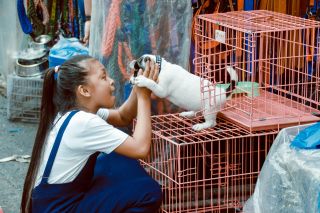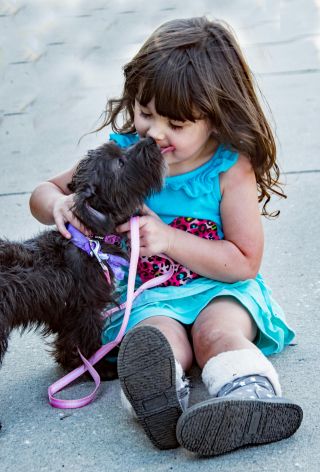Empathy
We Teach Them to Roll Over, They Teach Us Empathy
Animals promote empathy in children, leading to kinder individuals and societies.
Updated September 16, 2024 Reviewed by Tyler Woods
Key points
- Empathy is defined as the ability to perceive the inner mental states of others (including animals).
- Healthy empathy development leads to more positive social interactions and promotes prosocial behaviors.
- Involving children in caring animal interactions enhances empathy, perspective taking, and self-awareness.

Empathy is defined as the ability to perceive and be sensitive to the inner emotional and mental states of others (including animals), in combination with a motivation to care for their well-being. For example, when your close friend tearfully describes having suddenly lost a sorely needed job, you respond: “It sounds like you are going through a really hard time, and it makes sense that you feel sad and scared about the future. I’m here for you.” Empathy can also be nonverbal and present, for instance, as giving your friend a reassuring hug. As Brené Brown describes empathy, “It's simply listening. Holding space. Withholding judgment. Emotionally connecting. And communicating that incredibly healing message of ‘you’re not alone.’”
Empathy is an essential component of everyday social interactions, and it contributes to our ability as a species to live together, communicate effectively, and coordinate in groups. On the flip side, individuals with poor empathy skills often struggle in their personal and work relationships. With its essential role in helping maintain positive relationships, which have been repeatedly shown to be a key determinant of happiness and good health, empathy is integral to social, emotional, and physical well-being.
Empathy also increases prosocial behaviors, which help us build more caring and compassionate communities. Prosocial behaviors are behaviors intended to benefit others and include activities such as volunteering, sharing resources (e.g., sharing a toy with a playmate), and coordinating to complete a task. In a world where violence and cruelty surround us too often, empathy acts as an antidote and leads to more positive interactions, altruistic acts, and reduced stereotyping and exclusion. Empathy shapes communities into helping and caring networks.
Empathetic reactions can be seen in babies, but empathy development is not automatic in children. It results from a range of factors, including genetics, temperament, gradual brain maturation, and perhaps most importantly, a child’s early environment and experiences. For example, children exposed to caregivers who promote secure attachments are more likely to perceive and be sensitive to the emotions of others, having received attunement and empathy from their caregivers. Empathy development is fluid, and early influences can alter the course of a child’s development.

Animal Interactions and Empathy Development
This is where the benefits of childhood animal interactions come into play. The association between having an animal companion and increased overall empathy is well-researched, with dog guardianship significantly linked to greater empathy for animals and humans. The link between non-dog animal guardianship and greater empathy has been inconsistent, although more recent research suggests that any pet type is associated with greater empathy. One doesn’t need to have an animal companion to realize these benefits. Teachers report that classroom pets increase student compassion and empathy for animals, which then reverberates and extends to classmates. In addition, short-term animal therapy, which includes caring for the needs of animals, increases empathy levels in adolescent juvenile offenders, a population generally characterized by lower empathy levels. As these studies demonstrate, many different types of animal interventions can promote empathy development in children.
What Mechanism Causes This Effect?
It’s unclear how animal interactions lead to greater empathy in children. Perhaps caring for an animal expands a child’s (egocentric) world and directs focus onto other living beings. Animals are uniquely situated to help children learn empathy skills because they can’t verbalize their needs and feelings. This means that a child needs to think about what the animal needs and wants from the animal’s perspective (i.e., the child is developing the empathy skill of perspective taking, or the ability of the observer to adopt and understand the psychological perspective of another person). It also likely means that the child is having conversations with other children and adults about the animal’s emotions and needs (e.g., “Do you think the cat hurt herself when she jumped off the tall bookcase?”). These discussions about emotions and caring behaviors might also increase empathy.
In addition, children view animals as living beings with needs and desires but as different from people, and this characteristic may help children master another empathy skill called self-other distinctions, or the ability to distinguish between our thoughts and feelings and those of another living being. For instance, a child who learns her father is hungry might think that her father wants buttered noodles because that is the meal she craves when she is hungry, although, in reality, he wants sushi. However, the child would recognize that a pet dog who seems hungry needs more appropriate food for a dog (i.e., dog food and not buttered noodles), and this would be an opportunity to master the self-other distinction. Finally, of course, positive reinforcement from the appreciative animal, in the form of licks, cuddles, etc., leads to positive associations with empathetic behaviors.
Conclusion
Research demonstrates that animal interactions are associated with and promote empathy development in children. So the next time you have an opportunity to take your child to play with a neighbor’s dog, take home the classroom pet, or interact with animals at a farm, use it as a learning and growth experience for you and your child to become kinder people and more helpful members of society.
This post was written by guest blogger Talia Shulman, MSW, in collaboration with Dr. Kathy Compitus.
References
Brown, Brené. Daring Greatly: How the Courage to Be Vulnerable Transforms the Way We Live, Love, Parent, and Lead. New York, NY, Gotham Books, 2012.
Cloutier, A. & Peetz, J. (2016). “Relationships’ Best Friend: Links between Pet Ownership, Empathy, and Romantic Relationship Outcomes.” Anthrozoös., vol. 29, no. 3, pp. 395–408.
Daly, B. & Suggs, S. (2010). Teachers' experiences with humane education and animals in the elementary classroom: implications for empathy development. Journal of Moral Education, March 2010, Vol. 39 Issue 1, p101-112, 12p; DOI: 10.1080/03057240903528733
Dawson, J. (2016). Empathy through Animals: Generating Evidence-Based Outcomes for Empathy Development. Juvenile and Family Court Journal 67, No. (Issue 4), p.43.
Decety, J. & Holvoet, C. (2021). The emergence of empathy: A developmental neuroscience perspective. Developmental Review, 62. https://doi.org/10.1016/j.dr.2021.100999.
Komorosky D, O’Neal KK. The development of empathy and prosocial behavior through humane education, restorative justice, and animal-assisted programs. Contemporary Justice Review. 2015;18(4):395-406. doi:10.1080/10282580.2015.1093684
Reider, L. B., Kim, E., Mahaffey, E., & LoBue, V. (2023). The impact of household pets on children’s daily lives: Differences in parent–child conversations and implications for children’s emotional development. Developmental Psychology, 59(11), 2148–2161. https://doi.org/10.1037/dev0001595


